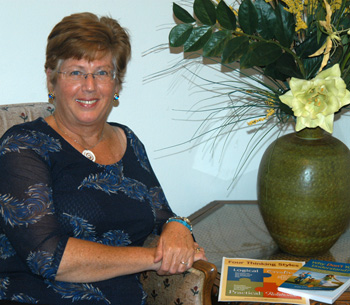Educator uses four-brain therapy theory to help resolve conflicts
Parent and life-skills educator Susie Weller believes awareness that people’s brains are biologically “wired differently” can help resolve conflicts in families, congregations and even politics.
 |
| Susie Weller |
Susie promotes the four-quadrant brain model, which is the concept of Whole Brain® thinking styles developed by researcher Ned Herrmann to help businesses improve decision-making by understanding different ways people think—1) logical,
2) practical, 3) creative and
4) relational.
“How couples relate and parent their children—tough, soft or in-between—is a result of their preferred brain styles,” she said in her book, Why Don’t You Understand: Improving Family Communication with the Four Thinking Styles, published in 2009 by Parenting Press in Seattle.
How churches deal with budget cuts—conflicts between facts-and-figures-only folk and mission-outreach minded is also tied with brain styles, she said.
Susie likens the four styles to use of fours historically to bring balance: Native Americans’ four directions, the Celtic cross symbolism of vertical and horizontal dimensions, and four elements of fire, earth, air and water.
“It’s about finding unity in the midst of diversity,” she said.
She believes conflict in families, congregations, schools, businesses and politics arises when people coming from one or two of those styles misunderstand what someone from other styles is saying or thinking.
Susie, who teaches afternoon classes to GED students in the Adult Basic Education program of Community Colleges of Spokane at Hillyard, Spokane Valley and North Monroe, offers practical tips, communication tools and stories of applications of the four thinking styles in her book.
Because no two children or adults are alike, parents and people in organizations need to adjust their communication to deal with the brain styles, as well as unique temperaments, so there’s no “one-size-fits-all” approach, she said.
Susie’s mother, who was also a parent educator, focused on temperament theories. Then Susie learned about the Myers-Briggs personality types during master’s studies in religious education and pastoral ministry at Seattle University in the 1980s.
After she earned a bachelor’s degree in communication studies and religious studies in 1976 from the University of Santa Barbara, her work as a Jesuit volunteer in campus ministry brought her to Seattle University.
In 1984, she married Mark Weller, who had also been a Jesuit volunteer. In 1989, they and their two children moved to Spokane, where she began teaching at the CCS Institute of Extended Learning program for parents of children in Headstart/ECEAP.
As a parenting and life-skills instructor, focusing on early childhood, she found “a dance between nature and nurture” to explain why people think, act and make decisions as they do.
“There are biological preferences. Like people are right or left handed, they are right or left brained,” she said. “If we understand that then, when there is conflict, we do not take it personally. We think in different styles.”
“The whole-brain approach helps us manage stress and deal with conflicts that may polarize people in extreme positions,” said Susie who seeks to help people appreciate differences.
The four styles are:
• The logical style focuses on the bottom line, details, quantifying and facts.
• The practical focuses on organizing and following through.
• The creative sees the big picture, metaphor, possibilities and opportunities.
• The relational is about one’s own feelings and other’s feelings.
Logical-practical minded are left-brain people and think similarly, as creative, relational people are right-brained, she said.
“When dealing with someone in the diagonally opposite quadrant, the brain requires more glucose—100 percent more energy—which can make it exhausting to communicate,” she said.
While many men may be more logical, and women, relational, the reverse may be true, too, said Susie, noting: “Opposites may attract but later drive people crazy.
“All four styles of thinking are important and complement each other. About 60 percent of people can access two styles, 30 percent can use three, and only four percent, all four. Those who use one may be experts, and those who can use all four, generalists.”
In family relationships, awareness of the four styles helps her respect differences with her husband, who is more creative and relational, while she is more practical and wants to plan ahead.
“When I’m in a conflict, I tend to speak louder in my own ‘language,’ like someone speaks English louder to someone who does not speak English,” she said.
Instead of becoming louder, she suggests shifting to a different style, from relational to logical in order to communicate with someone coming from that style.
Some may explain a point through stories, frustrating someone who wants to get to the point clearly and concisely, Susie said.
“Under stress, people often polarize to extreme positions, so they do not hear or value other views,” she said.
Susie said spiritual conflicts can also arise in families or congregations because of the differences.
For example, some pray best alone in a quiet room, and others pray out loud with others, recite traditional prayers or pray while walking, jogging or biking.
• Logical people may want clear principles to guide behavior.
• Practical people want prescribed practices for daily living. They like established traditions, prayers and old songs.
• Creative people like innovative worship and new forms of prayer and spirituality. They are ready for global justice issues.
• Relational people want to feel a sense of community.
To address the varied needs, some churches have two services—traditional and contemporary—and potlucks or support groups to help people relate, and preaching to share wisdom from Scriptures, life and the world.
Common tension in churches is between institutional survival, based on bottom-line preservation, and prophetic spirituality. Meanwhile, outside the church, she said, many question the relevance of churches and seek growth in new forms of spirituality.
“If a tradition is root bound, stuck in old forms, people wanting to explore may become rootless, like tumbleweed, picked up and thrown by new fads,” she said.
“The balance is to go to the roots of tradition that unite us and support us in exploring how to express wisdom for today. Then we see how principles guide us in daily life at home, work, in the community, nation and world,” she said. “Community nurtures wisdom and discernment,” she said. “It’s easy to make poor decisions without collective wisdom.
“If we listen to different perspectives, we expand dialogue, hearing perspectives in a setting with safety and respect for opposite points of view,” she said. “If people are discounted, they may take their disagreements underground and become aggressive or abusive.”
In the political realm, Susie said many media look at extremes rather than wise choices, playing up extreme views and ignoring reasoned dialogue on issues people face.
For information, call 255-6676 or email sweller@att.net or visit susieweller.com.
Copyright © October 2009 - The Fig Tree




